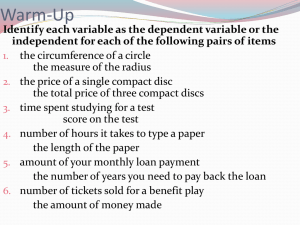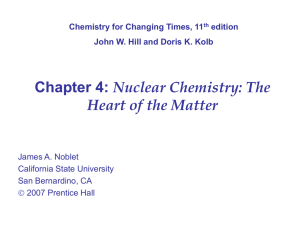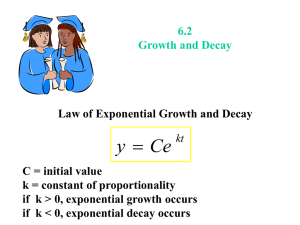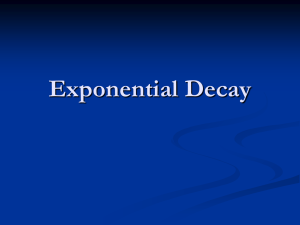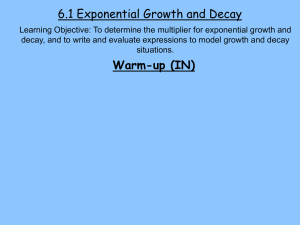Particle Reactions and Decays
advertisement
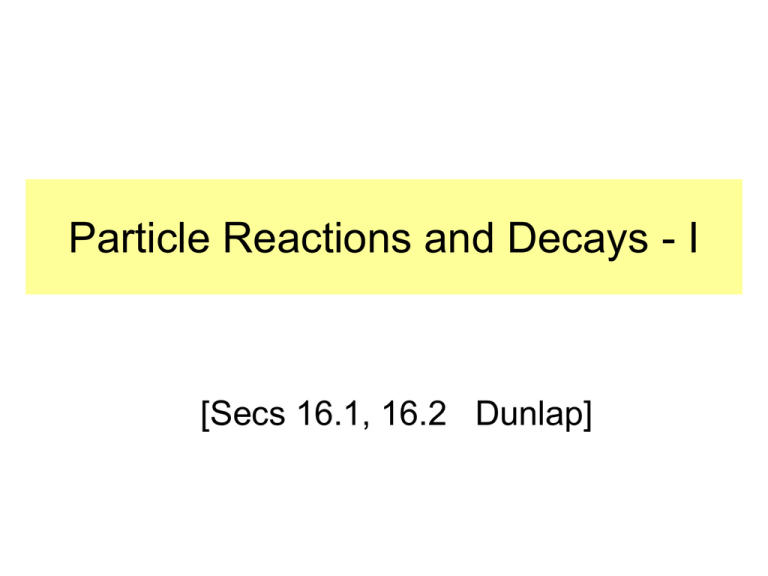
Particle Reactions and Decays - I [Secs 16.1, 16.2 Dunlap] REACTION ? No enough energy DECAY Q<0 ? Yes Q>0 CAN IT HAPPEN ? No Check B, Li, Qc Yes IS IT WEAK? T, S, C violation ? Yes WEAK W+, or W- involved. Flavor change occurs with one unit of charge change. No QUARKS LINK UP? Yes STRONG No γ in products Yes E.M. No TO HADRONS TO LEPTONS Classification of Decays No Type of Decay Particles Guage Bosons Example 1 Leptonic decay leptonleptons weak e e 2 Hadronic lepton decay leptonlepton+hadron weak 3 Hadronic decay hadronhadrons strong p 4 Nonleptonic hadron decay hadronhadrons strong+ weak 5 Semileptonic hadron decay hadronhadron+leptons weak n p e e 6 Leptonic hadron decay hadronleptons 7 Electromagnetic hadron decay hadronhadron+photon EM weak K p LEPTON DECAYS (i.e. decay into leptons) LEPTONIC DECAY HADRONIC – LEPTON DECAY HADRONIC DECAYS HADRONIC DECAY SEMI-LEPTONIC HADRON DECAY LEPTONIC HADRON DECAY NON-LEPTONIC HADRON DECAY ELECTROMAGNETIC HADRON DECAY In 1963 The UFI is back The quarks can exist either as eigenstates of the WEAK interaction or the STRONG interaction. Indeed it is best to think of the QUARKS as being fundamentally having FLAVOR STATES dw and sw determined via the WEAK interaction. Then comes along the STRONG interaction which MIXES these flavors into. In 1963 theoretical physicist Nicolo Cabibbo gave an explanation in terms of quark state mixing and introduced an angle The Cabibbo angle d d w cos sw sin s d w sin sw cos How the Quark Mixing works dw After switching on the STRONG interaction – these are the new quark states. d d d w cos c sw sin c θc sw θc s s d w sin c sw cos c The Cabibbo Angle turns out to be ~15° Cabbibo allowed – Cabibbo Surpressed d d d u s s Cabibbo Allowed d d d d s u Cabibbo Surpressed MEASURING THE CABIBBO ANGLE u W+ d u W+ K+ s K sin 2 c 2 tan c 2 cos c from which one finds tan c 0.075 Example 1 BETA MINUS DECAY n p e e All the primary conservation laws (above the line) are ok, so the reaction should go. But is it S, W, or EM? There are two things that indicate the primary classification is WEAK. These are (i) the fact that this T of the final state is N.D (not defined) and (ii) the fact that leptons are present in the final state. Having established that it is a W (weak) decay we then make the inference: WEAK DECAY INVOLVEMENT OF “W” PARTICLE Example 1 BETA MINUS DECAY n p e e FEYNMAN DIAGRAM CLASSIFICATION = Semileptonic Hadron Decay Example 2 ASSOCIATED PRODUCTION n K 0 All the primary conservation laws (above the line) are ok. Also the secondary conservation laws (obeyed by the strong interaction, ones below the line) are ok. This means the reaction must be mediated by the STRONG force. There will be NO Ws All quarks will “link up”. Example 2 ASSOCIATED PRODUCTION n K 0 FEYNMAN DIAGRAM CLASSIFICATION = PURE HADRONIC Example 3 K- MESON DECAY K All the primary conservation laws (above the line) are ok. But here the secondary conservation laws (obeyed by the strong interaction, ones below the line) are NOT OK. This is a clear indication that this cannot be a strong process. The presence of leptons also confirms that this must be a WEAK interaction process. the presence of W particles. Example 3 K- MESON DECAY K FEYNMAN DIAGRAM DECAY CLASSIFICATION = LEPTONIC HADRON DECAY Example 4 LAMDA ZERO DECAY As with the K+ decay we see failure on isospin and strangeness. Again this is clear indication that the WEAK interaction is responsible. [We saw in the lecture on strangeness that a strong interaction could only occur if the strange quark that had been produced could find another strange quark for pairing up with – and annihilating with] W PARTICLE involved in FLAVOR changing Example 4 LAMDA ZERO DECAY FEYNMAN DIAGRAM DECAY CLASSIFICATION = Nonleptonic Hadron decay Example 5 DELTA ++ PRODUCTION So all is OK for an allowed reaction and one going by the STRONG interaction. This a fully hadronic process. Example 5 DELTA ++ PRODUCTION FEYNMAN DIAGRAM CLASSIFICATION = Hadronic Reaction Example 6 D ZERO DECAY All is ok above the line – so the process is possible. Below the line we see a violation of strangeness and charm. Thus it looks as if we have a charmed quark changing into a strange quark. Involvement of a W boson. This is a WEAK process. Example 6 D ZERO DECAY FEYNMAN DIAGRAM DECAY CLASSIFICATION = Nonleptonic Hadron decay Example 7 D ZERO DECAY We see again an allowed decay but one which involves flavor changing on a quark. Here, however the presence of leptons in the final state makes finding the Feynman diagram easy. Example 7 D ZERO DECAY FEYNMAN DIAGRAM DECAY CLASSIFICATION = Semileptonic Hadron decay Example 8 e e 0

